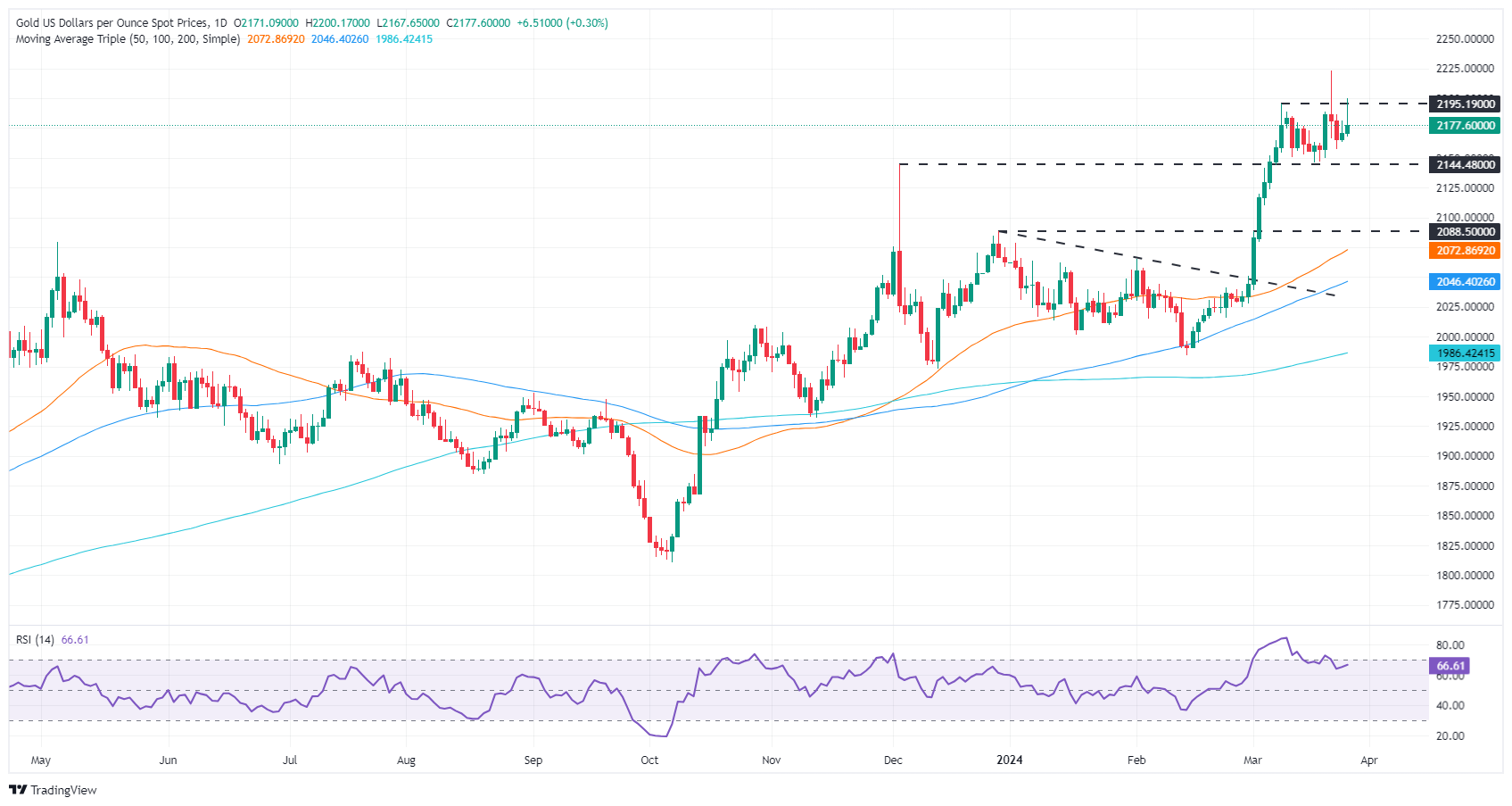Gold price firm amid buoyant US Dollar despite strong US data
- Gold rises amid US Dollar fluctuations and lower US Treasury yields.
- DXY's slight increase contests Gold's ascent, but bond rates boost it.
- Mixed US data: High Durable Goods Orders, lower Consumer Confidence sway sentiment.
Gold price trades in the green but is off the day's highs of $2,200 reached during the overnight session for North American traders amid a weaker US Dollar. At the opening of Wall Street, the Greenback extended its recovery while a fall in US Treasury yields maintained the yellow metal in the green. At the time of writing, XAU/USD trades at $2,177, up 0.31%.
The US Dollar Index (DXY), which measures the Greenback’s performance against the other six currencies, trades flat at 104.30, a headwind for the non-yielding metal. Nevertheless, the US 10-year benchmark note rate edged down one basis point to 4.243%, boosting the precious metal.
The US economic docket showed that Durable Goods Orders rose to their highest level since 2022. In the meantime, the Conference Board suggested that Consumer Confidence declined further in March, reaching its lowest level in four months.
Daily digest market movers: Gold advances amidst strong Durable Goods Orders
- US Durable Goods Orders for February rose by 1.4% MoM, exceeding estimates of 1.1% and January’s -0.9% plunge. The core Durable Goods Orders stood at 0.4% MoM, up from -0.3% and above the consensus of 0.4%.
- The Conference Board (CB) revealed Americans' confidence was steady in March, yet it ticked down to 104.7 from 104.8, a downward revision from the previous month. This was blamed on higher prices and soaring borrowing costs.
- Federal Reserve officials remain set to cut rates, but there’s division among the Federal Open Market Committee (FOMC) board. Atlanta Fed President Raphael Bostic noted that he expects one rate cut instead of two in 2024. Meanwhile, Fed Governor Lisa Cook echoed Bostic’s comments and added that easing policy too soon increases the risk of inflation becoming entrenched.
- Chicago Fed President Austan Goolsbee remains dovish, expecting three cuts, though he said he needs more evidence of inflation “coming down.”
- Money market traders predict a 70% chance that the Federal Reserve would slash rates by a quarter of a percentage point, setting the federal funds rate (FFR) at 5.00% - 5.25%.
- Gold traders are awaiting the release of the Federal Reserve’s preferred gauge for inflation, the Core Personal Consumption Expenditure (PCE) Price Index. The index is estimated to grow 2.8% YoY in February, with monthly figures expected to slow from 0.4% to 0.3% MoM.
Technical analysis: Gold price stays above $2,170 amid strong US Dollar

Gold price dips toward $2,167, spurring a leg up toward the $2,170 area at around the same time the Relative Strength Index (RSI) made a U-turn and aimed upwards. Nevertheless, buyers must reclaim the $2,200 figure to keep the uptrend unchanged. That will pave the way for re-testing the all-time high of $2,223.
On the flip side, if sellers push prices below the December 4 high, which turned support at $2,146, that could exacerbate a sell-off and send XAU/USD prices diving toward $2,100. The next support would be the December 28 high, which is $2,088.
Gold FAQs
Gold has played a key role in human’s history as it has been widely used as a store of value and medium of exchange. Currently, apart from its shine and usage for jewelry, the precious metal is widely seen as a safe-haven asset, meaning that it is considered a good investment during turbulent times. Gold is also widely seen as a hedge against inflation and against depreciating currencies as it doesn’t rely on any specific issuer or government.
Central banks are the biggest Gold holders. In their aim to support their currencies in turbulent times, central banks tend to diversify their reserves and buy Gold to improve the perceived strength of the economy and the currency. High Gold reserves can be a source of trust for a country’s solvency. Central banks added 1,136 tonnes of Gold worth around $70 billion to their reserves in 2022, according to data from the World Gold Council. This is the highest yearly purchase since records began. Central banks from emerging economies such as China, India and Turkey are quickly increasing their Gold reserves.
Gold has an inverse correlation with the US Dollar and US Treasuries, which are both major reserve and safe-haven assets. When the Dollar depreciates, Gold tends to rise, enabling investors and central banks to diversify their assets in turbulent times. Gold is also inversely correlated with risk assets. A rally in the stock market tends to weaken Gold price, while sell-offs in riskier markets tend to favor the precious metal.
The price can move due to a wide range of factors. Geopolitical instability or fears of a deep recession can quickly make Gold price escalate due to its safe-haven status. As a yield-less asset, Gold tends to rise with lower interest rates, while higher cost of money usually weighs down on the yellow metal. Still, most moves depend on how the US Dollar (USD) behaves as the asset is priced in dollars (XAU/USD). A strong Dollar tends to keep the price of Gold controlled, whereas a weaker Dollar is likely to push Gold prices up.